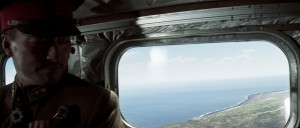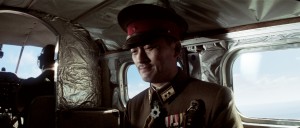Imagine compositing hundreds of ships and thousands of soliders and not shooting a frame of green screen.
In this podcast we speak to the team at Digital Domain about the issues involved with providing the visual effects for Letters from Iwo Jima.
There are few occasions where a film maker gets to tell a story from two completely opposite points of view, yet alone in two separate films. But this is exactly what Director Clint Eastwood did with the story of the battle of Iwo Jima.
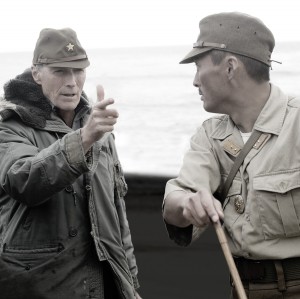
Eastwood recently said in an interview with Digital Content Producer Letters from Iwo Jima kind of came about as a curiosity when we were preparing Flags of our Fathers,? he explains. I kept going over story points, and how the defense of the island worked, and I finally got interested in General [Tadamichi] Kuribayashi [commander of the Japanese forces on the island]. I became curious about the story. So I told [screenwriter] Paul Haggis I didn’t have any dough, but that I had this crazy idea, and I asked if he had any students or anyone he could mentor along. He got [writer Iris Yamashita] to do some research, and she came up with the idea of following the general through the eyes of a young conscript.
“I said, Go ahead and write a script, and then I forgot about it, and we went and prepared Flags. One day, she came with a script, and it was quite good. I realized I was heading to Iceland and Iwo Jima, and that I could pick up a few shots for both films, so that is how it all came about. Everybody asked me why am I doing [two films]? I said, “It just seemed like the thing to do. We were in the mode, so why not?”
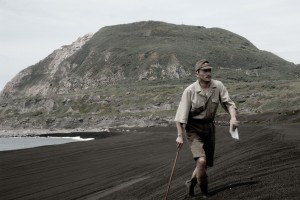
Digital Domain handled the vfx on Flags of Our Fathers and the director’s parallel film Letters from Iwo Jima, which tells the story of the same battle from the Japanese perspective. Digital Domain was called on to create photo-realistic landscapes, battle elements, and soldiers for nearly 760 VFX shots spanning both films.
Michael Owens, Matthew Butler, Brian Grill and Julian Lev have been already nominated for a VES Award for Flags of Our Fathers in the category of Outstanding Supporting Visual Effects in a Motion Picture. While the film itself has been nominated for Oscars in the categories of Best Picture, Sound Editing, Writing and Eastwood for Best Director.
Some of the most impresive shots from both films are the huge naval shots with hundreds of ships. Matthew Butler, vfx supervisor at Digital Domain, explains that much of the work in animating the landcraft and shots approaching the beach was done with Massive Software, the New Zealand software for intelligent agent simulation animation. Instead of using Massive for just people or soilder shots – which D2 did extensively, they also built intelligent ships and landing craft which each then were intelligent agents with goals, constraints and rules to guide their behaviour.
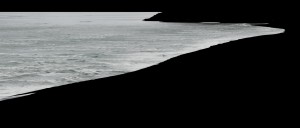
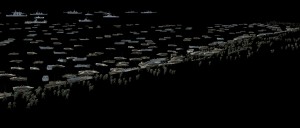
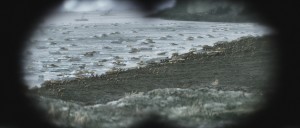
Flags and Letters were shot consecutively, Flags primarily in Iceland because its black-sand beaches are similar to those of Iwo Jima, with Letters being mainly shot in LA – as we learned in this week’s podcast with Digital Domain compositing supervisor Darren Poe. Digital Domain’s work included vast Navy shots, huge amounts of rotoscoping and on Flags, the compositing work also included turning all of the white sand beaches to black.
The roto on Letters and Flags was extremely innovative, and was the result of several years of work and development at D2. Firstly the roto scene and objects were tracked – this allowed for ‘cards’ to be placed in the scene that tracked the objects being rotoed. This meant that the individual artists needed to only adjust the shape but not track the roto manually around the shot.
Because the compositing and roto work was done in NUKE, the Digital Domain’s R&D engineers were able to write a critical custom tool to apply motion blur based on predictions of the movement inherent in each plate, resulting in highly realistic-looking composites. “The advantage of doing the roto in NUKE was that we could use the 3D system along with our camera tracking information to put all of the roto shapes in the correct space,” says Butler. “This allowed the splines to follow the movement of the camera and helped speed up the process.
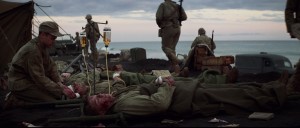
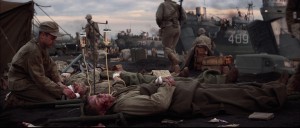
The process was described by Butler as “content dependent edge work.” He adds that “the roto was done on the plate photography, but rather than just do some cheesey blur on the edges to approximate the blur – which would look like a cheesey blur – we would do an optical flow analysis of the foreground photography and then apply the motion vectors to the roto shapes to produce a much more realistic and accurate result.
The roto team was headed up by Jeff Kim and some shots required between 20 plus roto artists to complete. This is before the optical flow work, the CG or the compositing. It was a massive undertaking. Bulter pointed out the lack of green screens was a double edge sword, while it did create a lot of work – it also meant that they got real lighting environments – with much more accurate scene lighting information than normal.
Poe noted that often times compositing shots of Mount Suribachi behind live action actors, smoke and dust was particularly difficult. All the Roto was done using D2’s commercially available Nuke package, which worked in concert with D2’s proprietary Track software written by Doug Roble at Digital Domain. “Every shot was pretty much tracked as the first thing we’d do – even if we didn’t think we’d need to” he explains in the podcast.
NUKE’s support of Open EXR coupled with its full featured 3D system also optimized workflow for Flags and Letters. By standardizing naming conventions and building gizmos, the compositing team was able to render a water shot, for example, which had 50 layers of surf, lighting, underwater caustics, whitecaps, etc., all incorporated into an EXR file, and bring up just waves or highlights to adjust them individually in context.
The compositors also built gizmos to create explosions and ground strafing for battle scenes, which allowed them to select between 32 individual CG pyro elements that could be used in any combination to create unique events, and custom lighting and color correction tools that gave them a fine level of control over the CG ships, vehicles, and soldiers.
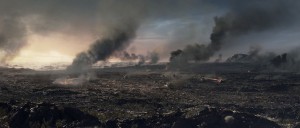 Poe, who specializes in photo-realistic VFX, noted, “The main difference between CG for a film like I Robot and something like Flags is that we’re doing a huge amount of work with the goal of having no one know we were there. The crew shot in Iceland, had a couple of tanks and boats, and a small group of soldiers. In the final shot there are 500 tanks, thousands of soldiers and boats and the Iwo Jima landscape – all blended into the scene photo-realistically to achieve what you see in the actual newsreel footage of that battle.
Poe, who specializes in photo-realistic VFX, noted, “The main difference between CG for a film like I Robot and something like Flags is that we’re doing a huge amount of work with the goal of having no one know we were there. The crew shot in Iceland, had a couple of tanks and boats, and a small group of soldiers. In the final shot there are 500 tanks, thousands of soldiers and boats and the Iwo Jima landscape – all blended into the scene photo-realistically to achieve what you see in the actual newsreel footage of that battle.

